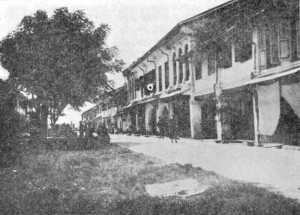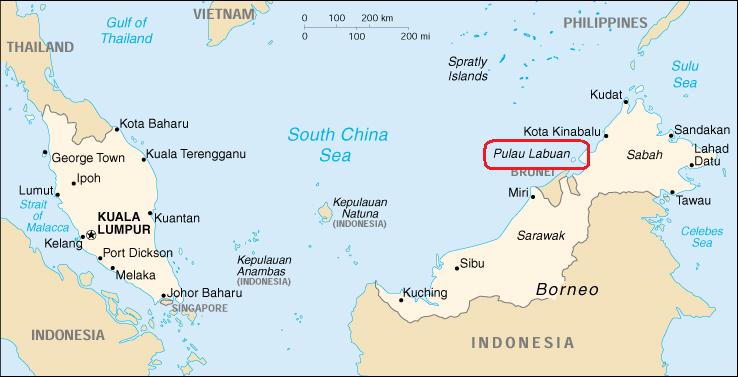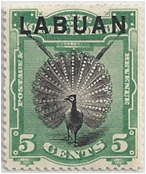Fast Facts
Region: Far East
Group: South East Asian Archipelago
Classification: Colony (British)
Prior Regime: Sultanate of Brunei
Key Dates:
1846, Dec 24 – Labuan ceded to the British from the Sultan of Brunei
1848 – Labuan becomes a British Crown Colony
1890, Jan 1 – British North Borneo Chartered Company begins administering Labuan
1904 – Labuan reverts back to British government rule
1906, Oct 30 – Labuan becomes part of the Straits Settlements Colony
Following Regime: Straits Settlements
Current Country: Malaysia
Scott Catalogue: (Labuan) #1-123, J1-J9
Pick Catalogue: none
History

Shortly after the British assumed control of the island, coal was discovered and the importance of Labuan became larger than merely a British port to fight piracy. In 1848, Labuan became a full British Crown Colony, and James Brooke, the first “White Rajah” of Sarawak was appointed Governor of the territory. Labuan was also declared a free port and open to settlers.
Although there was great interest in Labuan’s coal from many mining companies, most of the companies and the colony of Labuan itself was poorly managed. A high prevalence of malaria on the island also took its toll on workers and government officials. Coal trade soon declined and trading ships and coal carrying steamers begin to bypass Labuan, istead sailing to the China coasts instead. At one time owing to lack of steamers calling at Labuan, the coal at Victoria had accumulated to 8000 tons. The coal station was closed by the navy because of disuse.
In 1871, the British military garrison was pulled from Labuan, and by 1872 the British were seriously thinking of abandoning Labuan, but were did not want to provide a place for other powers to gain a foothold into the region. The colony continued to decline to a state of disrepair until in July 1889, The Chartered Company of North Borneo was asked if it would take over Labuan. The company began its administration of the island 1 Jan 1890, although Labuan officially remained a Crown Colony. Improvements began, even to the point of a telegraph line being installed in 1898 to Sandakan, the capital of North Borneo.
The change in administration, however, caused much friction between the local population, and petitions were sent to the Colonial Minister in London against the Chartered Company by disgruntled Labuan and Coal Company officials. This infighting continued until the colony was reverted back to British government rule in 1904, then on 30 October 1906 was joined to the Straits Settlements and administered from Singapore.

Stamps
 ALBUM
ALBUM
Initially, Labuan used stamps of Straits Settlements, but in May, 1879, Labuan began issuing its own Postage Stamps. The first stamps of Labuan featured the bust of Queen Victoria with the denomination written in three languages – English, Jawi, and Chinese. For about 15 years, multiple issues were printed with various colors and watermarks. Frequent shortages during the 1880’s necessitated a variety of surcharges to be issued.
In 1894, four years after the British North Borneo Company assumed control, the Queen Victoria design was replaced with company issued stamps from the “State of North Borneo” with “LABUAN” either engraved into the vignette or overprinted. The stamp designs included the Arms of North Borneo, a Dhow, a Crocodile, Mt. Kinabalu, and more, and were issued with multiple perforations and printings.
On 24 September 1896, the 50th anniversary of the cession to Great Britian, was commemorated with an overprint reading “1846 / JUBILEE / 1896” on the overprinted North Borneo designs. Additional overprints appeared through the 1890s. In 1899 many types were surcharged with a value of 4 cents.
The last Labuan-only design came out in 1902 which featured a crown and inscribed “LABUAN COLONY”. Additionally, in 1901, postage due stamps were issued by overprinting Labuan stamps with the words “POSTAGE DUE” vertically down the front of the stamp.
After incorporation into the Straits Settlements in 1906, Labuan ceased issuing its own stamps, although they remained valid for some time. The unused remainders of Labuan stamps were canceled to order by bars forming an oval and sold to collectors.
Banknotes
In the 1840s, the Indian rupee and the Spanish dollar was the most common currencies in British territories in the region. Also many of the chartered banks (e.g. the Chartered Bank and Hong Kong and Shanghai Bank) issued banknotes which circulated side by side with official currencies. In 1867, administration of the Straits Settlements was separated from India and the Straits Settlements dollar was also made a standard currency throughout the region. Beginning in 1890, British North Borneo banknotes (Pick #1-5) was issued and used in Labuan as well. These notes were equal 1:1 to the Straits Settlements dollar.
Links
History of Labuan
Philatelic and Postal History of Labuan from the The Sarawak Specialists’ Society
Rare Labuan Stamps from Sandafayre




